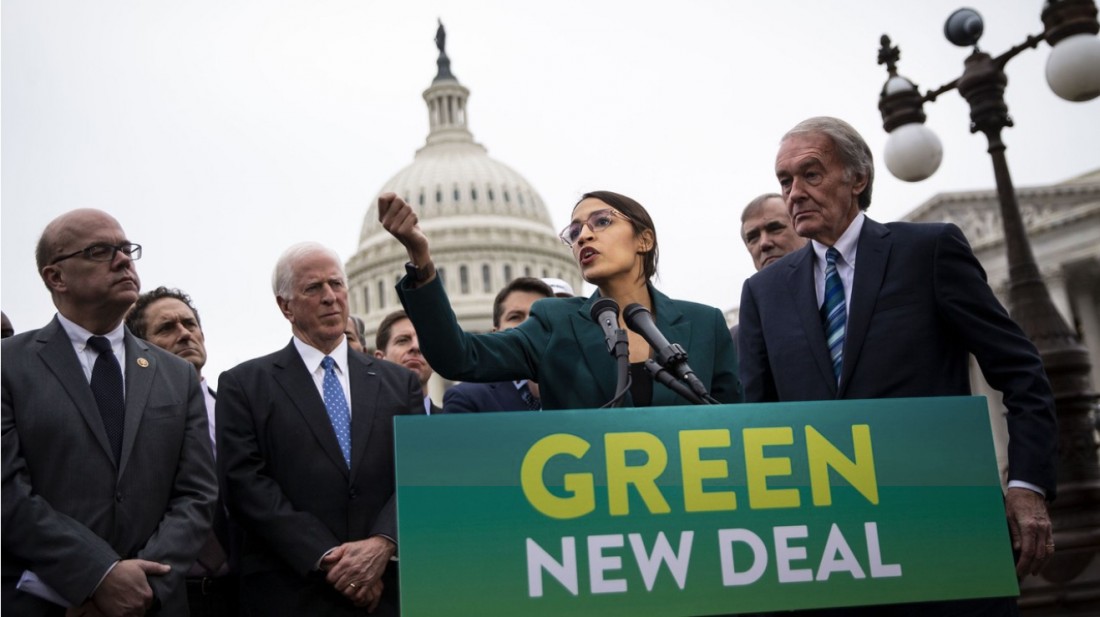
The Green New Deal
The Green New Deal.
What is it?
The Green New Deal is the name of House Resolution 109, which calls the federal government to take broad action against climate change.
Representative Alexandria Ocasio-Cortez (D-NY-14) and Senator Edward Markey (D-MA) introduced the resolution to the House of Representatives on February 7, 2019. Democratic Senators Elizabeth Warren (MA) and Cory Booker (NJ) both support it.
What’s in it?
These are the Green New Deal goals:
- “To achieve net-zero greenhouse gas emissions though a fair and just transition for all communities and workers.”
- “To create millions of good, high-wage jobs and ensure prosperity and economic security for all people of the United States.”
- “To invest in the infrastructure and industry of the United States to sustainably meet the challenges of the 21st century.”
- “To secure for all people of the United States for generations to come: (i) clean air and water; (ii) climate and community resiliency; (iii) healthy food; (iv) access to nature; and (v) a sustainable environment.”
- “To promote justice and equity by stopping current, preventing future, and repairing historic oppression of indigenous peoples, communities of color, migrant communities, deindustrialized communities, depopulated rural communities, the poor, low-income workers, women, the elderly, the unhoused, people with disabilities, and youth (referred to in this resolution as ‘frontline and vulnerable communities’).”
What is the timeline, and how will these goals be accomplished?
The Green New Deal goals are to be accomplished “through a 10-year national mobilization.” The mobilization requires the following goals and projects:
- “Building resiliency against climate change-related disasters, such as extreme weather, including by leveraging funding and providing investments for community-defined projects and strategies.”
- “Repairing and upgrading the infrastructure in the United States, including: (i) by eliminating pollution and greenhouse gas emissions as much as technologically feasible; (ii) by guaranteeing universal access to clean water; (iii) by reducing the risks posed by climate impacts; and (iv) by ensuring that any infrastructure bill considered by Congress addresses climate change.”
- “Meeting 100 percent of the power demand in the United States through clean, renewable, and zero-emission energy sources, including: (i) by dramatically expanding and upgrading renewable power sources; and (ii) by deploying new capacity.”
- “Building or upgrading to energy-efficient, distributed, and ‘smart’ power grids, and ensuring affordable access to electricity.”
- “Upgrading all existing buildings in the United States and building new buildings to achieve maximum energy efficiency, water efficiency, safety, affordability, comfort, and durability, including through electrification.”
- “Spurring massive growth in clean manufacturing in the United States and removing pollution and greenhouse gas emissions from manufacturing and industry as much as is technologically feasible, including by expanding renewable energy manufacturing and investing in existing manufacturing and industry.”
- “Working collaboratively with farmers and ranchers in the United States to remove pollution and greenhouse gas emissions from the agricultural sector as much as is technologically feasible, including: (i) by supporting family farming; (ii) by investing in sustainable farming and land use practices that increase soil health; and (iii) by building a more sustainable food system that ensures universal access to healthy food.”
- “Overhauling transportation systems in the United States to remove pollution and greenhouse gas emissions from the transportation sector as much as is technologically feasible, including through investment in (i) zero-emission vehicle infrastructure and manufacturing; (ii) clean, affordable, and accessible public transit; and (iii) high-speed rail.”
- “Mitigating and managing the long-term adverse health, economic, and other effects of pollution and climate change, including by providing funding for community-defined projects and strategies.”
- “Removing greenhouse gases from the atmosphere and reducing pollution by restoring natural ecosystems through proven low-tech solutions that increase soil carbon storage, such as land preservation and afforestation.”
- “Restoring and protecting threatened, endangered, and fragile ecosystems through locally appropriate and science-based projects that enhance biodiversity and support climate resiliency.”
- “Cleaning up existing hazardous waste and abandoned sites, ensuring economic development and sustainability on those sites.”
- “Identifying other emission and pollution sources and creating solutions to remove them.”
- “Promoting the international exchange of technology, expertise, products, funding, and services, with the aim of making the United States the international leader on climate action, and to help other countries achieve a Green New Deal.”
How can the United States achieve all of this?
The resolution details a series of broader goals and projects to achieve the Green New Deal goals and mobilization:
- “Providing and leveraging, in a way that ensures that the public receives appropriate ownership stakes and returns on investment, adequate capital (including through community grants, public banks, and other public financing), technical expertise, supporting policies, and other forms of assistance to communities, organizations, Federal, State, and local government agencies, and businesses working on the Green New Deal mobilization.”
- “Ensuring that the Federal Government takes into account the complete environmental and social costs and impacts of emissions through (i) existing laws; (ii) new policies and programs; and (iii) ensuring that frontline and vulnerable communities shall not be adversely affected.”
- “Providing resources, training, and high-quality education, including higher education, to all people of the United States, with a focus on frontline and vulnerable communities, so that all people of the United States may be full and equal participants in the Green New Deal mobilization.”
- “Making public investments in the research and development of new clean and renewable energy technologies and industries.”
- “Directing investments to spur economic development, deepen and diversify industry and business in local and regional economies, and build wealth and community ownership, while prioritizing high-quality job creation and economic, social, and environmental benefits in frontline and vulnerable communities, and deindustrialized communities, that may otherwise struggle with the transition away from greenhouse gas intensive industries.”
- “Ensuring the use of democratic and participatory processes that are inclusive of and led by frontline and vulnerable communities and workers to plan, implement, and administer the Green New Deal mobilization at the local level.”
- “Ensuring that the Green New Deal mobilization creates high-quality union jobs that pay prevailing wages, hires local workers, offers training and advancement opportunities, and guarantees wage and benefit parity for workers affected by the transition.”
- “Guaranteeing a job with a family-sustaining wage, adequate family and medical leave, paid vacations, and retirement security to all people of the United States.”
- “Strengthening and protecting the right of all workers to organize, unionize, and collectively bargain free of coercion, intimidation, and harassment.”
- “Strengthening and enforcing labor, workplace health and safety, antidiscrimination, and wage and hour standards across all employers, industries, and sectors.”
- “Enacting and enforcing trade rules, procurement standards, and border adjustments with strong labor and environmental protections (i) to stop the transfer of jobs and pollution overseas; and (ii) to grow domestic manufacturing in the United States.”
- “Ensuring that public lands, waters, and oceans are protected and that eminent domain is not abused.”
- “Obtaining the free, prior, and informed consent of indigenous peoples for all decisions that affect indigenous peoples and their traditional territories, honoring all treaties and agreements with indigenous peoples, and protecting and enforcing the sovereignty and land rights of indigenous peoples.”
- “Ensuring a commercial environment where every businessperson is free from unfair competition and domination by domestic or international monopolies.”
- “Providing all people of the United States with (i) high-quality health care; (ii) affordable, safe, and adequate housing; (iii) economic security; and (iv) clean water, clean air, healthy and affordable food, and access to nature.”
What’s next?
If the resolution passes the House, it still requires legislation to have the force of law. Representative Ocasio-Cortez’s office has said that a formal legislative proposal is forthcoming.
Source:
H.Res.109 – Recognizing the duty of the Federal Government to Create a Green New Deal, 116th Congress (2019-2020), February 07, 2019.

No Comments